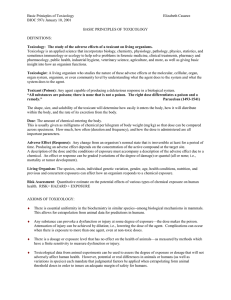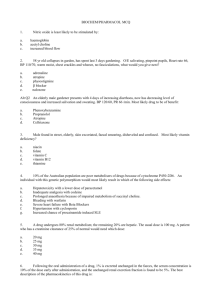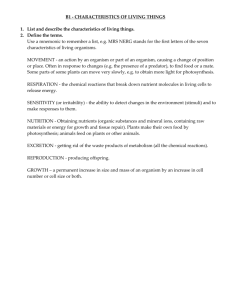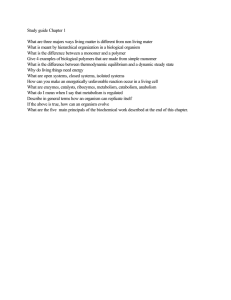Principles of Toxicology: The Study of Poisons
advertisement
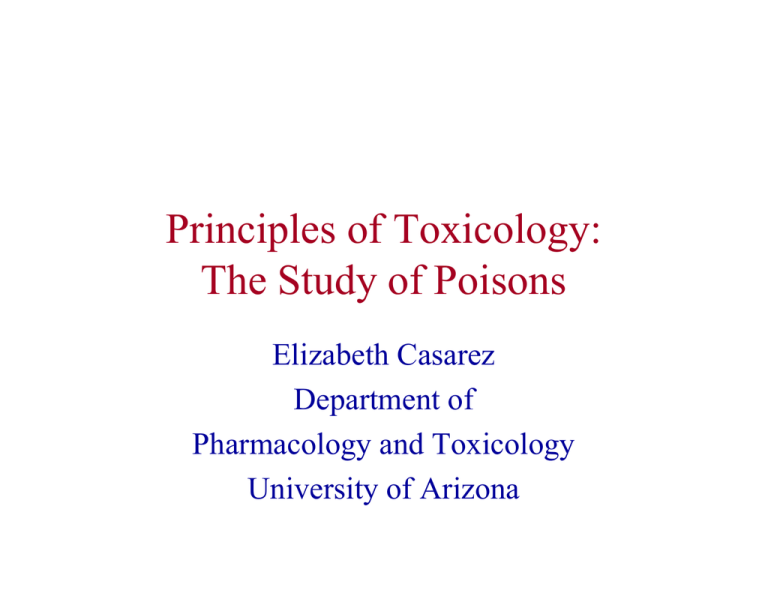
Principles of Toxicology: The Study of Poisons Elizabeth Casarez Department of Pharmacology and Toxicology U i University it off Arizona Ai The study of the adverse effects of a toxicant on living organisms • Adverse effects – any change from an organism’s normal state – dependent d d upon the h concentration i off active i compound at the target site for a sufficient time. • Toxicant T i t (Poison) (P i ) – any agent capable of producing a deleterious response in i a biological bi l i l system t • Living organism – a sac of water with target sites, storage depots and enzymes What is a Poison? All substances are poisons; there is none that is not a poison. poison The right dose diff differentiates i a poison i and d a remedy. d Paracelsus (1493-1541) Dose The amount of chemical entering the body Thi iis usually This ll given i as mg of chemical/kg of body weight = mg/kg The dose is dependent upon * The environmental concentration * The properties of the toxicant * The Th frequency f off exposure * The length of exposure * The exposure pathway What is a Response? The degree Th d andd spectra off responses depend d d upon the dose and the organism--describe exposure conditions with description of dose • Change g from normal state – could be on the molecular, cellular, organ, or organism level--the symptoms • • • • Local vs. Systemic Reversible vs vs. Irreversible Immediate vs. Delayed Graded d d vs. Quantall – degrees of the same damage vs. all or none Dose-Response Relationship: As the dose of a toxicant increases, so does the response. 4 RESPONSE 0-1 NOAEL 2 3 Linear Range 2-3 4 Maximum Response 3 2 0 1 DOSE DOSE DETERMINES THE BIOLOGICAL RESPONSE LD50 • Quantal responses can be treated as gradient when data from a population is used. • The Th cumulative l ti proportion ti off the th population l ti responding to a certain dose is plotted per d dose--10-30 10 30 ffold ld variation i ti w/in /i a population l ti • If Mortality is the response, the dose that is lethal to 50% of the population LD50 can be generated from the curve • Different toxicants can be compared-lowest dose is most potent LD50 Comparison Chemical Ch i l Ethyl Alcohol Sodium Chloride Ferrous Sulfate Morphine Sulfate Strychnine y Sulfate Nicotine Black Widow Curare Rattle Snake Dioxin (TCDD) B t li Botulinum toxin t i LD50 (mg/kg) ( /k ) 10,000 4,000 1,500 900 150 1 0.55 0 50 0.50 0.24 0.001 0 0001 0.0001 Exposure: Pathways • Routes and Sites of Exposure – – – – Ingestion (Gastrointestinal Tract) Inhalation (Lungs) Dermal/Topical (Skin) I j ti Injection • intravenous, intramuscular, intraperitoneal • Typical Effectiveness of Route of Exposure iv > inhale > ip > im > ingest > topical Exposure: Duration Acute Subacute S b h i Subchronic Chronic < 24hr 1 month 13 1-3mo > 3mo usually 1 exposure repeated doses repeated t d doses d repeated doses Over time,, the amount of chemical in the body can build up, it can redistribute, or it can overwhelm repair p and removal mechanisms ADME: Absorption, Distribution, Metabolism and Excretion Metabolism, • Once a living organism has been exposed to a toxicant, toxicant the compound must get into the body and to its target site in an active form in order to cause an adverse effect. effect • The body has defenses: – Membrane barriers • passive and facilitated diffusion, active transport – Biotransformation Bi f i enzymes, antioxidants i id – Elimination mechanisms Absorption: ability of a chemical to enter the blood (blood is in equilibrium with tissues) • Inhalation Inhalation--readily absorb gases into the blood stream via the alveoli. (Large alveolar surface, high blood flow, and proximity of blood to alveolar air) • Ingestion-g absorption p through g GI tract stomach (acids), small intestine (long contact time, large surface area--villi; bases and transporters for others) – 1st Pass Effect (liver can modify) • Dermal--absorption through epidermis (stratum corneum), then dermis; site and condition of skin Distribution: the process in which a chemical agent g the bodyy translocates throughout • Blood carries the agent to and from its site off action, ti storage t depots, d t organs off transformation, and organs of elimination • Rate of distribution (rapid) dependent upon – blood flow – characteristics of toxicant (affinity for the tissue, and the partition coefficient) • Distribution may change over time Distribution: Storage and Binding • Storage in Adipose tissue tissue--Very Very lipophylic compounds (DDT) will store in fat. Rapid mobilization of the fat (starvation) can rapidly increase blood concentration • Storage S iin Bone--Chemicals B Ch i l analogous l to Calcium--Fluoride, Lead, Strontium • Binding to Plasma proteins--can displace endogenous compounds. Only free is available for adverse effects or excretion Target Organs: adverse effect is dependent upon the concentration of active compound at the target site for enough time • Not N t all ll organs are affected ff t d equally ll – greater susceptibility of the target organ – higher concentration of active compound • • • • • • Liver--high blood flow, oxidative reactions Kidney--high blood flow, concentrates chemicals Lung--high blood flow, Lung flow site of exposure Neurons--oxygen dependent, irreversible damage M Myocardium-di oxygen dependent Bone marrow, intestinal mucosa--rapid divide Target Sites: Mechanisms of Action • Adverse effects can occur at the level of the molecule, cell, organ, or organism • Molecularly, chemical can interact with Proteins Lipids DNA • Cellularly, C ll l l chemical h i l can – – – – – interfere with receptor-ligand binding interfere with membrane function interfere with cellular energy production bind to biomolecules perturb homeostasis (Ca) Excretion: Toxicants are eliminated from the body by several routes • Urinary Ui excretion ti – water soluble products are filtered out of the bl d bby th blood the kidney kid andd excreted t d into i t the th urine i • Exhalation – Volatile compounds are exhaled by breathing • Biliary y Excretion via Fecal Excretion – Compounds can be extracted by the liver and excreted into the bile. The bile drains into the small intestine and is eliminated in the feces. • Milk Sweat Saliva Metabolism: adverse effect depends on the concentration of active compound at the target site over time • The process by which the administered chemical (parent compounds) are modified by the organism by enzymatic reactions. reactions • 1o objective--make chemical agents more water soluble and easier to excrete – decrease lipid solubility --> > decrease amount at target – increase ionization --> increase excretion rate --> decrease toxicity • Bioactivation--Biotransformation can result in the formation of reactive metabolites Biotransformation (Metabolism) • Can drastically effect the rate of clearance of compounds • Can occur at any point during the compound’s journey from absorption to excretion Compound Co pou d Ethanol W t out Without Metabolism 4 weeks Wt With Metabolism 10mL/hr Phenobarbital 5 months 8hrs DDT Days to weeks infinity Biotransformation • Key organs in biotransformation – LIVER (high) – Lung, Kidney, Intestine (medium) – Others (low) • Biotransformation Pathways * Ph Phase II--make k th the toxicant t i t more water t soluble l bl * Phase II--Links with a soluble endogenous agent (conjugation) Individual Susceptibility --there can be 10-30 fold difference in response to a toxicant in a population • Genetics-species, strain variation, interindividual variations (yet still can extrapolate between mammals--similar biological mechanisms) • Gender (gasoline ( li nephrotox h t in i male l mice i only) l ) • Age--young (old too) – underdeveloped excretory mechanisms – underdeveloped biotransformation enzymes – underdeveloped blood-brain barrier Individual Susceptibility • Age--old – changes in excretion and metabolism rates, body fat • Nutritional status • Health conditions • Previous P i or Concurrent C t Exposures E – additive – synergistic --antagonistic Toxicology • • • • • • • • Exposure + Hazard E H d = Risk Ri k All substances can be a poison D Dose ddetermines i the h response Pathway, Duration of Frequency of Exposure and Ch i l determine Chemical d t i Dose D Absorption, Distribution, Metabolism & Excretion Th extent off the The h effect ff is i dependent d d upon the h concentration of the active compound at its site of action over time Bioactivation: compounds to reactive metabolites Individual variation of the organism will affect ADME

